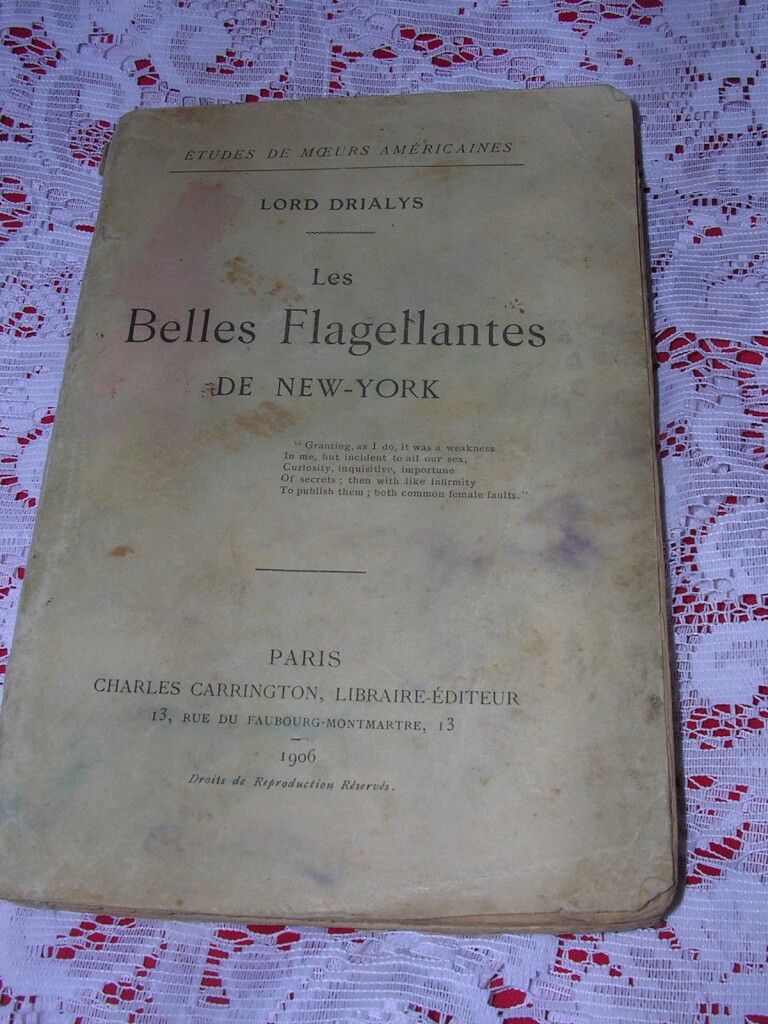-
 Etude Sur La Bestialite Au Point de Vue Historique, Medical et Juridique, G. Dubois-Desaulle (Charles Carrington, Paris, 1905, #437/500, printed Felix Guy et Cie, Aleçon) 10"x7.25", 2 volumes, xii+443pp, Holland paper , modern binding half-calf over red boards, gilt title and decorations on spine, original paper covers bound inside, fore and bottom edges deckled, some pages uncut, very good condition for age, clean. Study of bestiality from the historical, medical and legal point of view. A very nice copy of a VERY rare book.
Etude Sur La Bestialite Au Point de Vue Historique, Medical et Juridique, G. Dubois-Desaulle (Charles Carrington, Paris, 1905, #437/500, printed Felix Guy et Cie, Aleçon) 10"x7.25", 2 volumes, xii+443pp, Holland paper , modern binding half-calf over red boards, gilt title and decorations on spine, original paper covers bound inside, fore and bottom edges deckled, some pages uncut, very good condition for age, clean. Study of bestiality from the historical, medical and legal point of view. A very nice copy of a VERY rare book. -
Out of stock
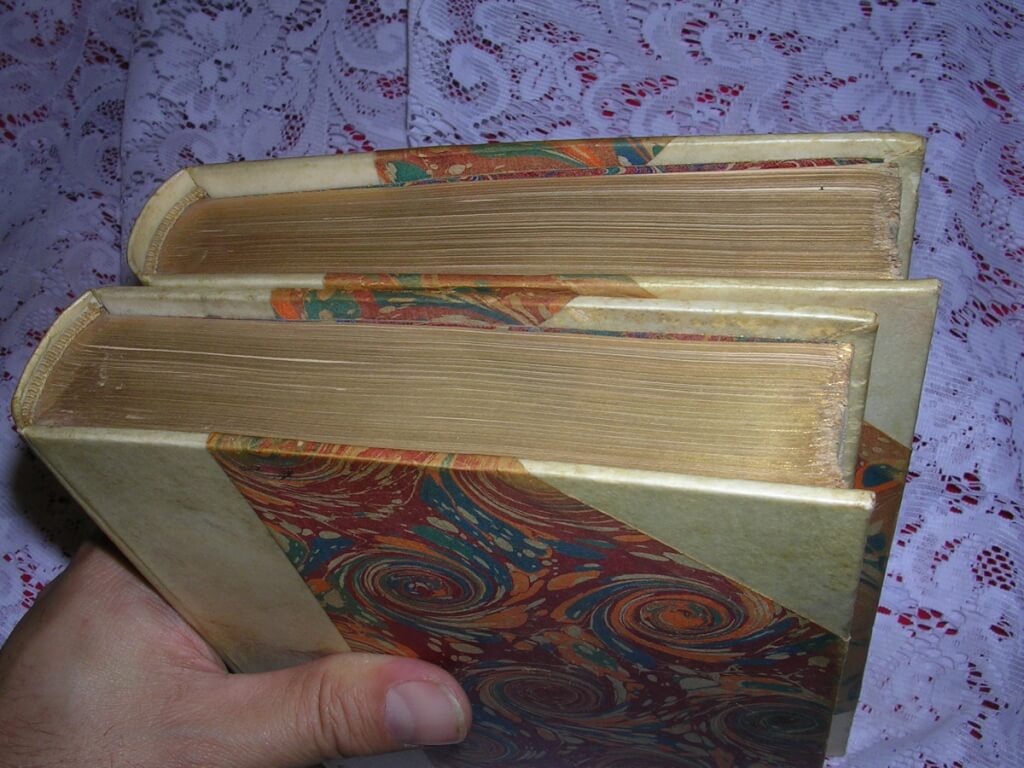
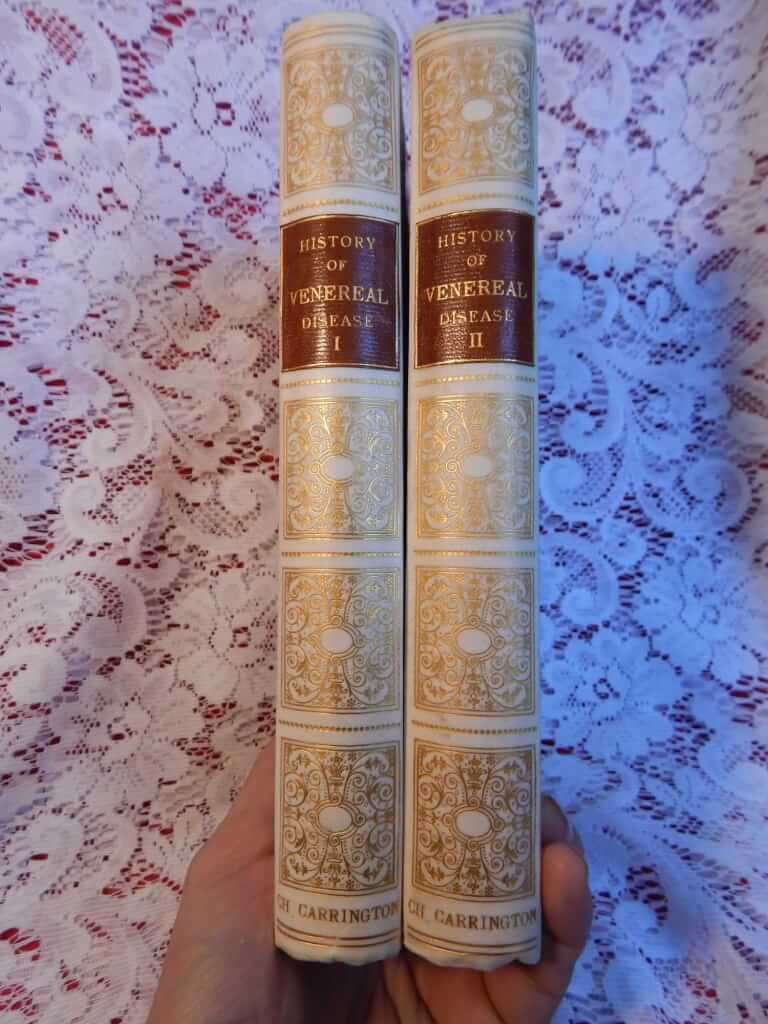 Dr. Julius Rosenbaum, trans. (from German) by "An Oxford M.A." (Charles Carrington, Paris, 1901) 9" X 5.5" 2 vol., xxxvi 297pp. (3 pages of ads), v. 342pp. Hardbound 1/2-bound in vellum over decorated boards, gilt lettering on spine, top edge gilt, other edges deckle. Marlbled endpapers. Very good condition, binding tight #84/500
Dr. Julius Rosenbaum, trans. (from German) by "An Oxford M.A." (Charles Carrington, Paris, 1901) 9" X 5.5" 2 vol., xxxvi 297pp. (3 pages of ads), v. 342pp. Hardbound 1/2-bound in vellum over decorated boards, gilt lettering on spine, top edge gilt, other edges deckle. Marlbled endpapers. Very good condition, binding tight #84/500 -
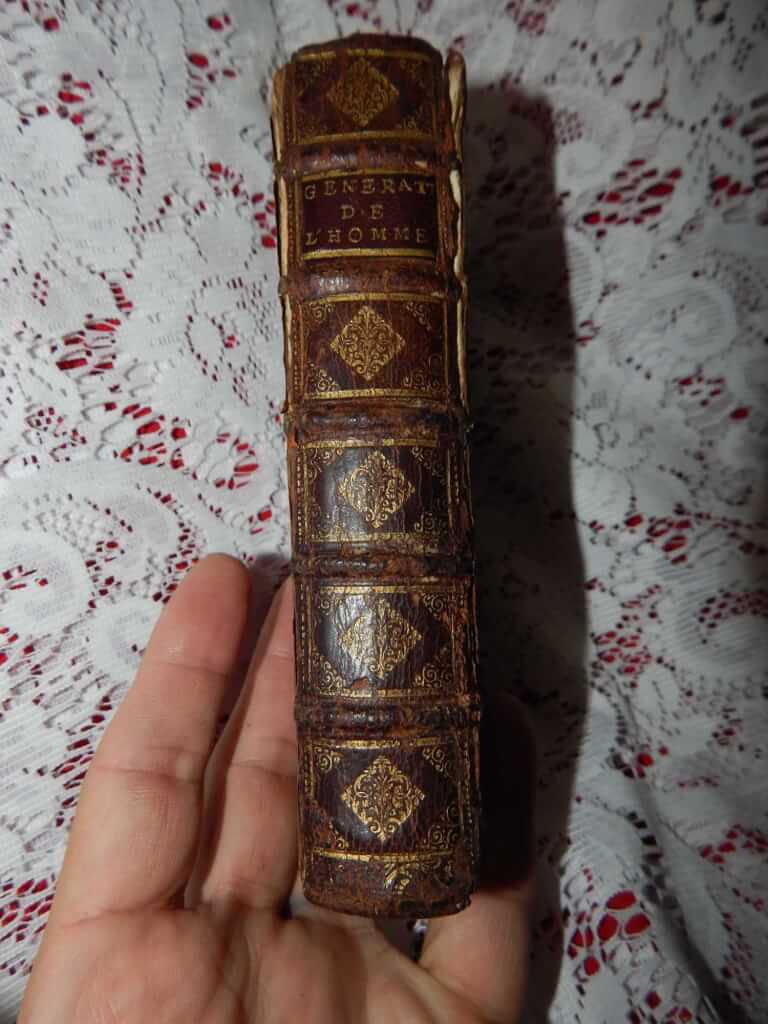
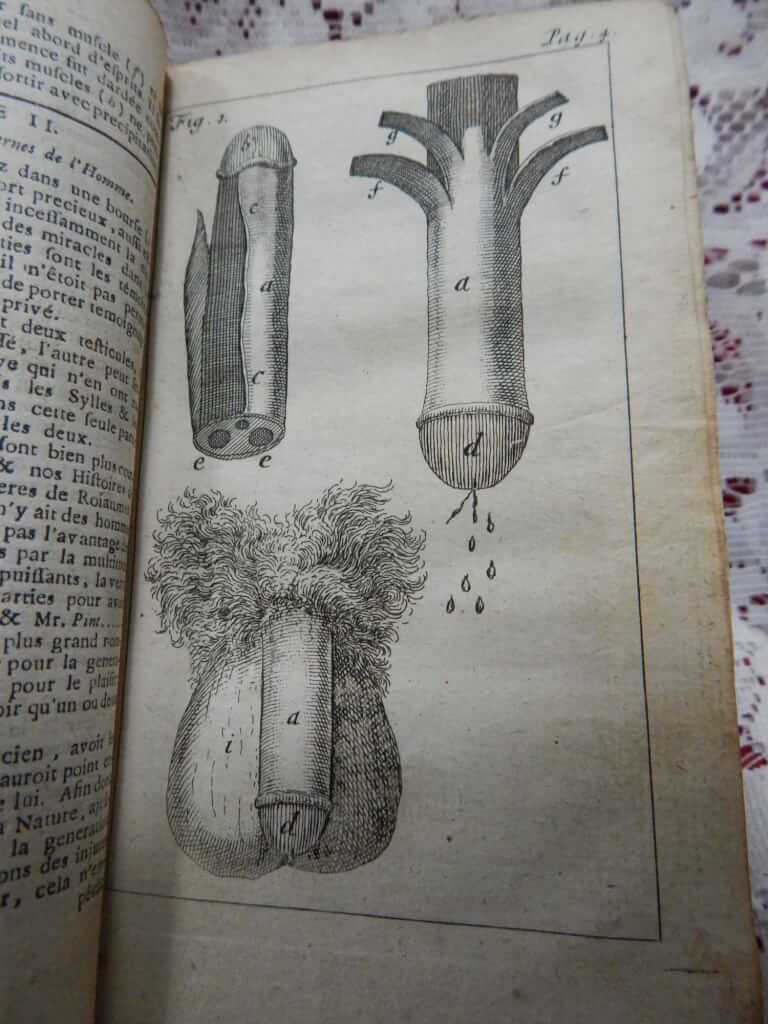 Tableau de l’amour conjugal, ou l'Histoire complète de la génération de l’homme, Nicolas Venette (Claude Joly, Cologne 1712) 3.75"x6", 22+384pp +4, full calf, 5 raised bands, gilt titles and decorations on spine, front boards loose, good condition for age. Illustrated throughout. Nicolas Venette (1633–1698) was a physician, sexologist and French writer. Born in La Rochelle, he studied medicine at Bordeaux where he received his doctorate in 1656. He then went to Paris where he studied under Guy Patin and Pierre Petit, before travelling to Spain, Portugal and Italy. He then returned to La Rochelle, where he became Regius Professor of Anatomy and Surgery in 1668. First published in Amsterdam in 1686 as Tableau de l'amour humain considéré dans l'état du mariage (Table of human love considered in the state of marriage) under the pseudonym Salocini Venetian (anagram of Nicolas Venette), this book, more properly titled Table of conjugal love, or the complete history of the generation of man, is considered to be the first treatise on sexology in West. It proved to be a bestseller and was translated into English, Spanish, German and Dutch. There were 33 editions published sporadically until 1903. This is a rare earlier version, published in 1712. The author discusses four sub-topics with respect to sex: anatomy, reproduction, desire, and impotence/infertility. For each topic, he reviews ancient and medieval authors, adding his own observations or those of later authors, and comments where common sense prevails. The resulting composition has an ambiguous mixture of seriousness and light-heartedness bordering upon erotic literature.
Tableau de l’amour conjugal, ou l'Histoire complète de la génération de l’homme, Nicolas Venette (Claude Joly, Cologne 1712) 3.75"x6", 22+384pp +4, full calf, 5 raised bands, gilt titles and decorations on spine, front boards loose, good condition for age. Illustrated throughout. Nicolas Venette (1633–1698) was a physician, sexologist and French writer. Born in La Rochelle, he studied medicine at Bordeaux where he received his doctorate in 1656. He then went to Paris where he studied under Guy Patin and Pierre Petit, before travelling to Spain, Portugal and Italy. He then returned to La Rochelle, where he became Regius Professor of Anatomy and Surgery in 1668. First published in Amsterdam in 1686 as Tableau de l'amour humain considéré dans l'état du mariage (Table of human love considered in the state of marriage) under the pseudonym Salocini Venetian (anagram of Nicolas Venette), this book, more properly titled Table of conjugal love, or the complete history of the generation of man, is considered to be the first treatise on sexology in West. It proved to be a bestseller and was translated into English, Spanish, German and Dutch. There were 33 editions published sporadically until 1903. This is a rare earlier version, published in 1712. The author discusses four sub-topics with respect to sex: anatomy, reproduction, desire, and impotence/infertility. For each topic, he reviews ancient and medieval authors, adding his own observations or those of later authors, and comments where common sense prevails. The resulting composition has an ambiguous mixture of seriousness and light-heartedness bordering upon erotic literature. -

 Confessions of a Lady's Waiting Maid: being a true record of her marvelous adventures in both hemispheres, Fanny Beresford [Charles Paul de Kock (probably pseudonyms of George Thompson)] (J. H. Farrell, New York, nd [1848]) 9.5" X 5.75", 340pp, original soft covers, back cover missing, front cover and original orange paper front illustration page detached. Top and bottom edges untrimmed. Poor condition but for the age in good shape for a cheaply made and well read paperback. A museum piece. This is a very rare surviving paperback from the publisher Jeremiah H. Farrell. One of three main publishers of erotica of the time, According to Comstock (famous New York prosecutor of obscenity) "Farrell published about 109 different books. He had been at it about sixteen years, at the time of his death in 1873." The story was written by George Thompson who was the most prolific author of American erotica of the mid-nineteenth century, who got his start in Boston and later relocated to New York. Thompson wrote under numerous pseudonyms. The name of Charles Paul de Kock (a popular French novelist of the time) was a popular pseudonym of erotic work in America for obvious reasons.
Confessions of a Lady's Waiting Maid: being a true record of her marvelous adventures in both hemispheres, Fanny Beresford [Charles Paul de Kock (probably pseudonyms of George Thompson)] (J. H. Farrell, New York, nd [1848]) 9.5" X 5.75", 340pp, original soft covers, back cover missing, front cover and original orange paper front illustration page detached. Top and bottom edges untrimmed. Poor condition but for the age in good shape for a cheaply made and well read paperback. A museum piece. This is a very rare surviving paperback from the publisher Jeremiah H. Farrell. One of three main publishers of erotica of the time, According to Comstock (famous New York prosecutor of obscenity) "Farrell published about 109 different books. He had been at it about sixteen years, at the time of his death in 1873." The story was written by George Thompson who was the most prolific author of American erotica of the mid-nineteenth century, who got his start in Boston and later relocated to New York. Thompson wrote under numerous pseudonyms. The name of Charles Paul de Kock (a popular French novelist of the time) was a popular pseudonym of erotic work in America for obvious reasons. -
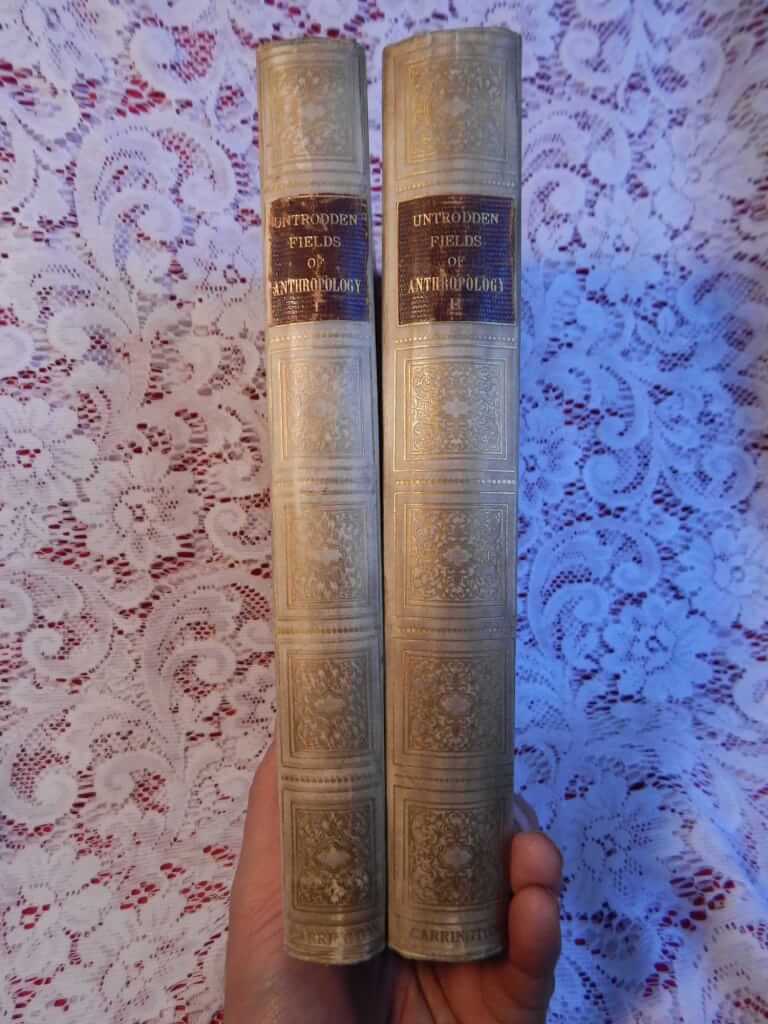
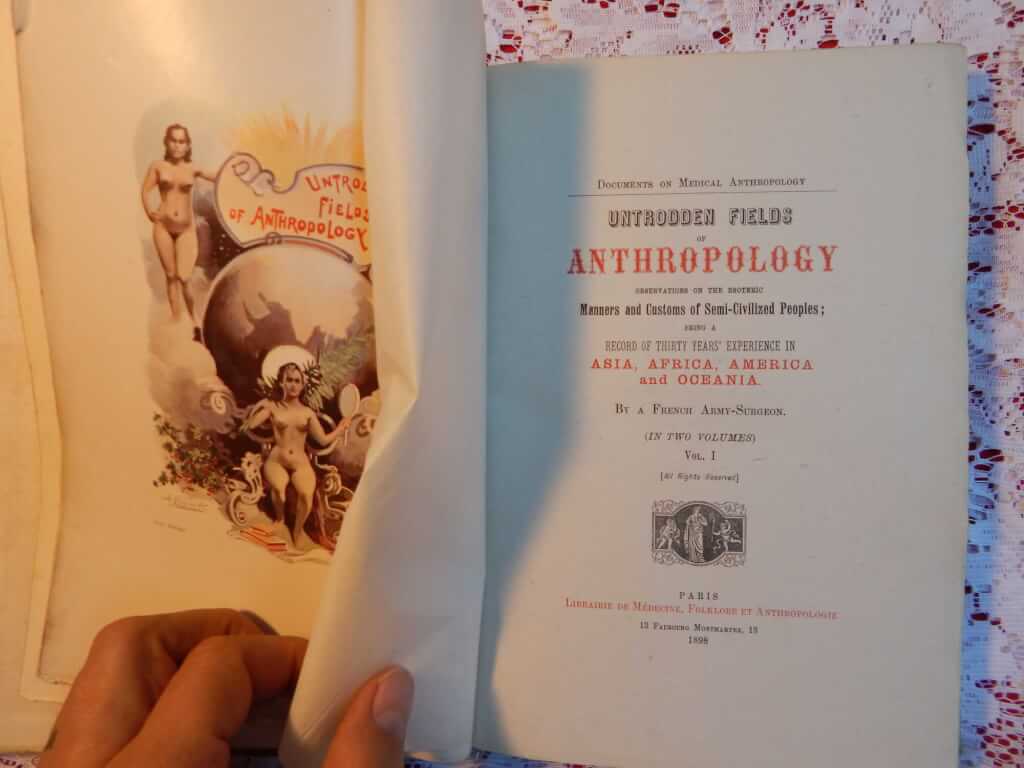 Documents on Medical Anthropology | Untrodden Fields of Anthropology | observations on the esoteric Manners and Customs of Semi-Civilized Peoples; being a record of thirty years' experience in asia, africa, america, and oceana., "By a French Army-Surgeon [in later books identified as "Jacobus X.."] (Charles Carrington, Paris, 1898, "second enlarged and revised edition [was there a first?]", #52/150, "printed on papier de chine") 7"x10" 2 vol., xl+ 341pp, xiv+502pp, Hardbound with paper wrappers inside, 1/2-bound in vellum over marbled boards, gilt lettering on spine, top edge gilt, other edges deckle/uncut, fine hand-laid paper, marlbled endpapers, binding tight, color frontispiece and numerous B&W full page engravings with descriptive tissue guards, very rare copy, bookplates of Frederic Roa This work of ''anthropology'' seems in fact intended to serve the purposes of titillation with its detailed descriptions of exotic sexual practices. Also present in this edition (to be presumably studied) are illustrations of naked women from all over the world. This is a rare book, often mentioned but not seen.
Documents on Medical Anthropology | Untrodden Fields of Anthropology | observations on the esoteric Manners and Customs of Semi-Civilized Peoples; being a record of thirty years' experience in asia, africa, america, and oceana., "By a French Army-Surgeon [in later books identified as "Jacobus X.."] (Charles Carrington, Paris, 1898, "second enlarged and revised edition [was there a first?]", #52/150, "printed on papier de chine") 7"x10" 2 vol., xl+ 341pp, xiv+502pp, Hardbound with paper wrappers inside, 1/2-bound in vellum over marbled boards, gilt lettering on spine, top edge gilt, other edges deckle/uncut, fine hand-laid paper, marlbled endpapers, binding tight, color frontispiece and numerous B&W full page engravings with descriptive tissue guards, very rare copy, bookplates of Frederic Roa This work of ''anthropology'' seems in fact intended to serve the purposes of titillation with its detailed descriptions of exotic sexual practices. Also present in this edition (to be presumably studied) are illustrations of naked women from all over the world. This is a rare book, often mentioned but not seen. -

 The Old Man Young Again, or Age-Rejuvenescence in the Power of Concupiscence, [Ibn-I Kemal Pasa] "literally translated from the arabic by an English Bohemian" (Charles Carrington, Paris, 1898 [first edition]) 5.25"x8.5", xi 265pp, hard bound in brown boards with gilt titles over red on spine, pages uniformly yellowed, good condition for age, binding good A very rare translation of an arabic how-to sex manual with much emphasis on aphrodisiacs with a forward by Carrington. Very few copies of this Carrington publication still exist.
The Old Man Young Again, or Age-Rejuvenescence in the Power of Concupiscence, [Ibn-I Kemal Pasa] "literally translated from the arabic by an English Bohemian" (Charles Carrington, Paris, 1898 [first edition]) 5.25"x8.5", xi 265pp, hard bound in brown boards with gilt titles over red on spine, pages uniformly yellowed, good condition for age, binding good A very rare translation of an arabic how-to sex manual with much emphasis on aphrodisiacs with a forward by Carrington. Very few copies of this Carrington publication still exist. -
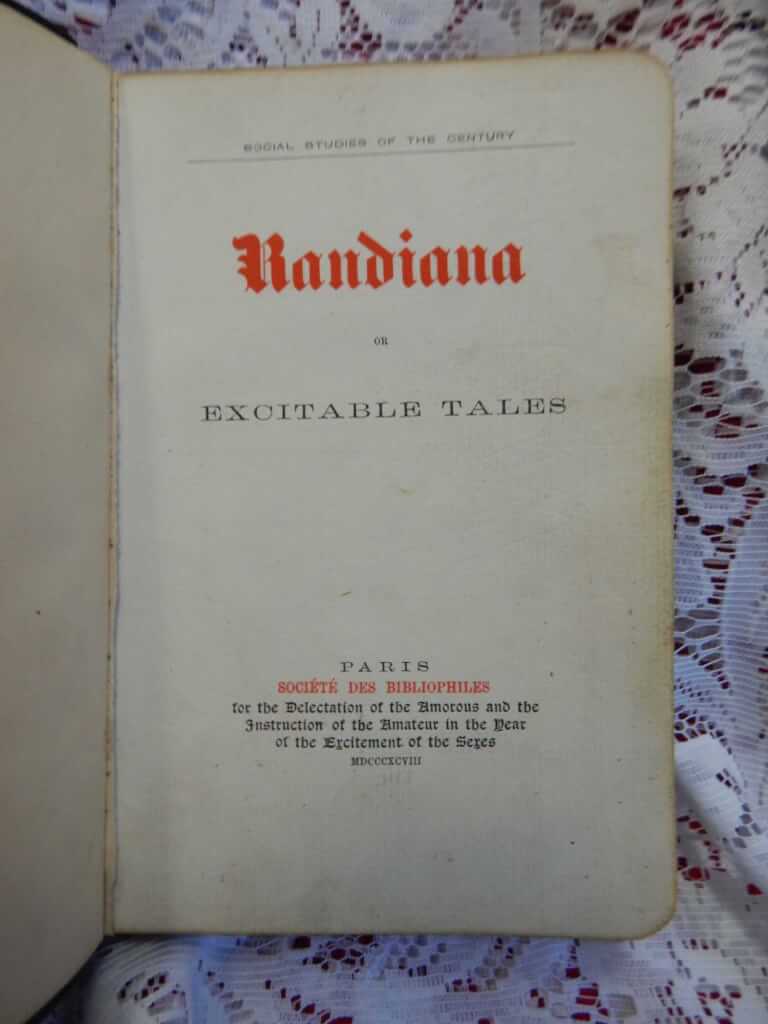
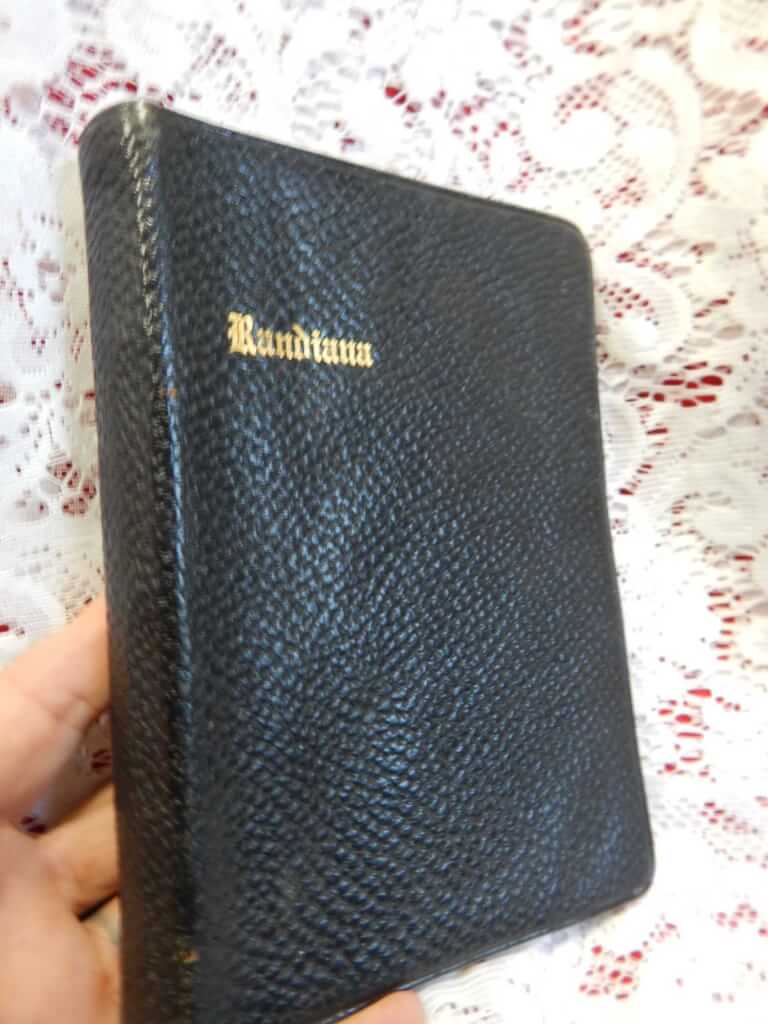 Randiana or Excitable Tales, (Société des Bibliophiles [actually Charles Carrington, as part of the stated "Social Studies of the Century" series, reads "for the Delectation of the Amorous and the Instruction of the Amateur in the year of the Excitement of the Sexes". This exact edition is different than mentioned in Mendez.], 1898 5.25"x7.75", 142pp, bound in soft bible-like leather, decorated endpapers, printed on Van Gelder hand-laid paper cut with rounded corners (also bible-like), pages 55-60 loose, otherwise good condition for age, rare and uniquely presented edition of this very erotic work. Randiana, or Excitable Tales is an anonymously written pornographic novel originally published by William Lazenby in 1884. The book depicts a variety of sexual activities, including incest, defloration and lesbianism. From an 1899 ad: "... A Rare Lascivious English Classic! … this is a book written by an English gentleman of considerable wit, command of language, and an imagination of Rabelaisian order. Erotic as are these tales, they are far from being filthy, while a plot of thrilling interest runs throughout the work, binding all the stories together, as with chains of gold. Each story is complete in itself and yet… incomplete without the rest. The events narrated too, are all perfectly natural and might have occurred to any coynte-hunter besides James CLINTON. The story of flagellation is most exciting; “The effects of shell-fish” simply delightful; and the glorious circumvention of proud, cold, haughty, fine-limbed Lady LEVERSON’S dearly guarded chastity, is simply rapturous - one can almost see the movings of her mighty snow-white buttocks, hear her delightful cries, gasps, murmers, pantings of real pleasure, while she rolls, wriggles, jumps, throbs, becomes joy-delirious, as she is prodded by the powerful tool of the man bestriding her, and who has here been bold enough to put his experiences on record. Price £3.3s. P.S. - This book, until lately, was absolutely unfindable and, under the title of The Apotheosis of Prick,£18 was being asked for it."
Randiana or Excitable Tales, (Société des Bibliophiles [actually Charles Carrington, as part of the stated "Social Studies of the Century" series, reads "for the Delectation of the Amorous and the Instruction of the Amateur in the year of the Excitement of the Sexes". This exact edition is different than mentioned in Mendez.], 1898 5.25"x7.75", 142pp, bound in soft bible-like leather, decorated endpapers, printed on Van Gelder hand-laid paper cut with rounded corners (also bible-like), pages 55-60 loose, otherwise good condition for age, rare and uniquely presented edition of this very erotic work. Randiana, or Excitable Tales is an anonymously written pornographic novel originally published by William Lazenby in 1884. The book depicts a variety of sexual activities, including incest, defloration and lesbianism. From an 1899 ad: "... A Rare Lascivious English Classic! … this is a book written by an English gentleman of considerable wit, command of language, and an imagination of Rabelaisian order. Erotic as are these tales, they are far from being filthy, while a plot of thrilling interest runs throughout the work, binding all the stories together, as with chains of gold. Each story is complete in itself and yet… incomplete without the rest. The events narrated too, are all perfectly natural and might have occurred to any coynte-hunter besides James CLINTON. The story of flagellation is most exciting; “The effects of shell-fish” simply delightful; and the glorious circumvention of proud, cold, haughty, fine-limbed Lady LEVERSON’S dearly guarded chastity, is simply rapturous - one can almost see the movings of her mighty snow-white buttocks, hear her delightful cries, gasps, murmers, pantings of real pleasure, while she rolls, wriggles, jumps, throbs, becomes joy-delirious, as she is prodded by the powerful tool of the man bestriding her, and who has here been bold enough to put his experiences on record. Price £3.3s. P.S. - This book, until lately, was absolutely unfindable and, under the title of The Apotheosis of Prick,£18 was being asked for it." -

 The Old Man Young Again, or Age-Rejuvenescence in the Power of Concupiscence, [Ibn-I Kemal Pasa] "literally translated from the arabic by an English Bohemian" (Charles Carrington, Paris, 1898 [first edition]) 9" X 5.5", xi 265pp, original soft covers, unread copy (most pages uncut on top, some uncut fore edge). Protective wraps. A very rare translation of an arabic how-to sex manual with much emphasis on aphrodisiacs with a forward by Carrington. Very few copies of this Carrington publication still exist. This is particularly unique because many pages remain uncut. I know of no other copies in this unread condition!
The Old Man Young Again, or Age-Rejuvenescence in the Power of Concupiscence, [Ibn-I Kemal Pasa] "literally translated from the arabic by an English Bohemian" (Charles Carrington, Paris, 1898 [first edition]) 9" X 5.5", xi 265pp, original soft covers, unread copy (most pages uncut on top, some uncut fore edge). Protective wraps. A very rare translation of an arabic how-to sex manual with much emphasis on aphrodisiacs with a forward by Carrington. Very few copies of this Carrington publication still exist. This is particularly unique because many pages remain uncut. I know of no other copies in this unread condition! -
 Fanny Hill's Cook Book, Lionel H. Braun & William Adams, illustrations by Brian Forbes (Taplinger Publishing Co., Inc., New York, 1971 [first edition]) 9 3/8" X 6 1/8", 137pp, hardbound with DJ, good condition, binding tight, some soiling to front boards, few tears in dust jacket Rare and raunchy 70's cookbook. Highlights include "Whores d'oeuvres and snacks" featuring "Dildoughs with Warts in Hot Lips", "Pickled Peckers" and Marquise d'Salade with Crafty Ebbing Undressing". In the "Meat Dishes" section there is "Suc d'Meat", "Rump Roast or Backside Entree", and "Fellatio Mignon". There is a whole section "On Stuffing." The pasta section features "Cunnilinguini with Pietro's Tongue" and the dessert features among others "Jock's Strap", "The Nutcracker Sweet" and "Virgin's pushups with a few bawdy stories thrown in between the recipes. The illustrations are very fun. Very 70's. A good copy of a rare book.
Fanny Hill's Cook Book, Lionel H. Braun & William Adams, illustrations by Brian Forbes (Taplinger Publishing Co., Inc., New York, 1971 [first edition]) 9 3/8" X 6 1/8", 137pp, hardbound with DJ, good condition, binding tight, some soiling to front boards, few tears in dust jacket Rare and raunchy 70's cookbook. Highlights include "Whores d'oeuvres and snacks" featuring "Dildoughs with Warts in Hot Lips", "Pickled Peckers" and Marquise d'Salade with Crafty Ebbing Undressing". In the "Meat Dishes" section there is "Suc d'Meat", "Rump Roast or Backside Entree", and "Fellatio Mignon". There is a whole section "On Stuffing." The pasta section features "Cunnilinguini with Pietro's Tongue" and the dessert features among others "Jock's Strap", "The Nutcracker Sweet" and "Virgin's pushups with a few bawdy stories thrown in between the recipes. The illustrations are very fun. Very 70's. A good copy of a rare book. -
 The Ballad of Reading Gaol, Oscar Wilde, Latimer J. Wilson illus. (F.M. Buckles & Company, New York, 1907) 6.5”x9.75″, 55pp, grey/violet cloth with gilt and black and white decorations and titles, top-edge gilt others deckled, corners bumped, binding and internal pages are in excellent condition. The Ballad of Reading Gaol is a poem by Oscar Wilde, written in exile in Berneval-le-Grand, after his release from Reading Gaol on 19 May 1897. Wilde had been incarcerated in Reading after being convicted of gross indecency with other men in 1895 and sentenced to two years' hard labour in prison. During his imprisonment, a hanging took place. Charles Thomas Wooldridge had been a trooper in the Royal Horse Guards. He was convicted of cutting the throat of his wife earlier that year at Clewer, near Windsor. He was aged 30 when executed. Wilde wrote the poem in mid-1897 while staying with Robert Ross in Berneval-le-Grand. The poem narrates the execution of Wooldridge; it moves from an objective storytelling to symbolic identification with the prisoners as a whole. No attempt is made to assess the justice of the laws which convicted them, but rather the poem highlights the brutalization of the punishment that all convicts share. Wilde juxtaposes the executed man and himself with the line "Yet each man kills the thing he loves". Wilde too was separated from his wife and sons. He adopted the proletarian ballad form, and suggested it be published in Reynold's Magazine, "because it circulates widely among the criminal classes – to which I now belong – for once I will be read by my peers – a new experience for me". The finished poem was published by Leonard Smithers in 1898 under the name "C.3.3.", which stood for cell block C, landing 3, cell 3. This ensured that Wilde's name – by then notorious – did not appear on the poem's front cover. It was not commonly known, until the 7th printing in June 1899, that C.3.3. was actually Wilde. The poem brought him a small income for the rest of his life. This edition, beautifully decorated by Latimer J. Wilson and published by F.M. Buckles & Company appears to be a very rare. There are no other copies of this edition currently on sale. I have found a few in private collections and libraries using WorldCat database but no copies appear to be in circulation.
The Ballad of Reading Gaol, Oscar Wilde, Latimer J. Wilson illus. (F.M. Buckles & Company, New York, 1907) 6.5”x9.75″, 55pp, grey/violet cloth with gilt and black and white decorations and titles, top-edge gilt others deckled, corners bumped, binding and internal pages are in excellent condition. The Ballad of Reading Gaol is a poem by Oscar Wilde, written in exile in Berneval-le-Grand, after his release from Reading Gaol on 19 May 1897. Wilde had been incarcerated in Reading after being convicted of gross indecency with other men in 1895 and sentenced to two years' hard labour in prison. During his imprisonment, a hanging took place. Charles Thomas Wooldridge had been a trooper in the Royal Horse Guards. He was convicted of cutting the throat of his wife earlier that year at Clewer, near Windsor. He was aged 30 when executed. Wilde wrote the poem in mid-1897 while staying with Robert Ross in Berneval-le-Grand. The poem narrates the execution of Wooldridge; it moves from an objective storytelling to symbolic identification with the prisoners as a whole. No attempt is made to assess the justice of the laws which convicted them, but rather the poem highlights the brutalization of the punishment that all convicts share. Wilde juxtaposes the executed man and himself with the line "Yet each man kills the thing he loves". Wilde too was separated from his wife and sons. He adopted the proletarian ballad form, and suggested it be published in Reynold's Magazine, "because it circulates widely among the criminal classes – to which I now belong – for once I will be read by my peers – a new experience for me". The finished poem was published by Leonard Smithers in 1898 under the name "C.3.3.", which stood for cell block C, landing 3, cell 3. This ensured that Wilde's name – by then notorious – did not appear on the poem's front cover. It was not commonly known, until the 7th printing in June 1899, that C.3.3. was actually Wilde. The poem brought him a small income for the rest of his life. This edition, beautifully decorated by Latimer J. Wilson and published by F.M. Buckles & Company appears to be a very rare. There are no other copies of this edition currently on sale. I have found a few in private collections and libraries using WorldCat database but no copies appear to be in circulation. -
 The Life and Adventures of Father Silas | written by himself and now first translated from the original French edition (dated 1742), anonymous [attributed to Jean-Charles Gervaise de Latouche], (np [Charles Hirsch?], London, 1907) 7" X 4.5", 185pp, beautifully bound full red morocco with gilt border on boards, gilt decorations and title on spine, 5 raised bands, deckled edges, illustrations not present, good+ condition, slight internal foxing, a beautiful copy of a rare book. Originally published in French, Histoire de Dom Bougre, Portier des Chartreux is a French novel from 1741. Allegedly the anonymous author was Jean-Charles Gervaise de Latouche. Histoire de Dom Bougre is one of the most celebrated French erotic novels of the 18th century, and one of the most frequently reprinted. The novel was published under a variety of titles in French: Histoire de Dom B... (1741), Histoire de Gouberdom (1772), Mémoires de Saturnin (1787), Le Portier des chartreux (1784) and Histoire de Saturnin (1908). Translations into English have appeared under a similar variety of titles, such as The History of Don [sic] B. (1743), The Life and Adventures of Silas Shovewell (1801) and The History of Father Saturnin alias Don B*** alias Gouberdom – Porter of the Charterhouse at Paris (ca. 1827). The novel tells from the first-person perspective the life story of the monk B... (the acronym stands for Bougre, a French vulgar expression for pederast), whose real name is Saturnin. Saturnin's first sexual intercourse is with his sister Suzon and his mother. Even if it turns out later that in reality there is no blood relationship, the text heralds an incessant series of taboo breaking with this alleged incest. In the further course of numerous humorously designed scenes, Saturnin will experience all varieties of sexual disinhibition, whereby ruthless criticism of church and society is also practiced in constant alternation. Finally, Saturnin meets the syphilis sister in a brothel. He loves her sincerely and spends the night with her, although she warns him about the risk of infection. The two are torn apart the next day; Saturnin falls ill and is forcibly castrated to save his life, Suzon dies. In the end, Saturnin finds refuge in a Carthusian monastery, where, freed from all passions, he can await death, which he neither fears nor longs for. He would like the words: Hic situs est Dom Bougre, fututus, futuit (Here lies Dom Bougre, he fucked, and was fucked), to be inscribed on his grave. Jean-Charles Gervaise de Latouche (1715 - 1782), was a French writer. He was a lawyer at the Parlement de Paris of the Ancien Régime. The authorship of the licentious books Mémoires de Mademoiselle de Bonneval (1738), Histoire de Dom Bougre, Portier des Chartreux (1741), and possibly also Lyndamine, ou, L'optimisme des pays chauds (1778) has been attributed to him. Charles Hirsch was a French bookseller in Victorian London who sold French literature and ran a clandestine trade in expensive pornography. Hirsch's bookshop Librairie Parisienne was at Coventry Street, London. He also published in Paris and translated pornographic works from French to English and vice versa. Hirsch knew Oscar Wilde, and claimed to have sold him various works of erotica, including The Sins of the Cities of the Plain in 1890. Hirsch describes how Wilde brought the manuscript of Teleny to his bookshop in 1890 instructing that it be held until a friend, who would be carrying Wilde's card, came to retrieve it. "A few days later one of the young gentlemen I had seen with [Wilde] came to collect the package. He kept it for a while and then brought it back saying in turn: 'Would you kindly give this to one of our friends who will come to fetch it in the same person's name'". Hirsch recounts three further repetitions of this "identical ceremony" before the package made its way back to Wilde. Hirsch defied the strict instructions not to open the package while it was in his care, and claims that it was written in several different hands, which lends further support to his supposition that it was authored in "round robin" style by a small group of Wilde's intimate associates.
The Life and Adventures of Father Silas | written by himself and now first translated from the original French edition (dated 1742), anonymous [attributed to Jean-Charles Gervaise de Latouche], (np [Charles Hirsch?], London, 1907) 7" X 4.5", 185pp, beautifully bound full red morocco with gilt border on boards, gilt decorations and title on spine, 5 raised bands, deckled edges, illustrations not present, good+ condition, slight internal foxing, a beautiful copy of a rare book. Originally published in French, Histoire de Dom Bougre, Portier des Chartreux is a French novel from 1741. Allegedly the anonymous author was Jean-Charles Gervaise de Latouche. Histoire de Dom Bougre is one of the most celebrated French erotic novels of the 18th century, and one of the most frequently reprinted. The novel was published under a variety of titles in French: Histoire de Dom B... (1741), Histoire de Gouberdom (1772), Mémoires de Saturnin (1787), Le Portier des chartreux (1784) and Histoire de Saturnin (1908). Translations into English have appeared under a similar variety of titles, such as The History of Don [sic] B. (1743), The Life and Adventures of Silas Shovewell (1801) and The History of Father Saturnin alias Don B*** alias Gouberdom – Porter of the Charterhouse at Paris (ca. 1827). The novel tells from the first-person perspective the life story of the monk B... (the acronym stands for Bougre, a French vulgar expression for pederast), whose real name is Saturnin. Saturnin's first sexual intercourse is with his sister Suzon and his mother. Even if it turns out later that in reality there is no blood relationship, the text heralds an incessant series of taboo breaking with this alleged incest. In the further course of numerous humorously designed scenes, Saturnin will experience all varieties of sexual disinhibition, whereby ruthless criticism of church and society is also practiced in constant alternation. Finally, Saturnin meets the syphilis sister in a brothel. He loves her sincerely and spends the night with her, although she warns him about the risk of infection. The two are torn apart the next day; Saturnin falls ill and is forcibly castrated to save his life, Suzon dies. In the end, Saturnin finds refuge in a Carthusian monastery, where, freed from all passions, he can await death, which he neither fears nor longs for. He would like the words: Hic situs est Dom Bougre, fututus, futuit (Here lies Dom Bougre, he fucked, and was fucked), to be inscribed on his grave. Jean-Charles Gervaise de Latouche (1715 - 1782), was a French writer. He was a lawyer at the Parlement de Paris of the Ancien Régime. The authorship of the licentious books Mémoires de Mademoiselle de Bonneval (1738), Histoire de Dom Bougre, Portier des Chartreux (1741), and possibly also Lyndamine, ou, L'optimisme des pays chauds (1778) has been attributed to him. Charles Hirsch was a French bookseller in Victorian London who sold French literature and ran a clandestine trade in expensive pornography. Hirsch's bookshop Librairie Parisienne was at Coventry Street, London. He also published in Paris and translated pornographic works from French to English and vice versa. Hirsch knew Oscar Wilde, and claimed to have sold him various works of erotica, including The Sins of the Cities of the Plain in 1890. Hirsch describes how Wilde brought the manuscript of Teleny to his bookshop in 1890 instructing that it be held until a friend, who would be carrying Wilde's card, came to retrieve it. "A few days later one of the young gentlemen I had seen with [Wilde] came to collect the package. He kept it for a while and then brought it back saying in turn: 'Would you kindly give this to one of our friends who will come to fetch it in the same person's name'". Hirsch recounts three further repetitions of this "identical ceremony" before the package made its way back to Wilde. Hirsch defied the strict instructions not to open the package while it was in his care, and claims that it was written in several different hands, which lends further support to his supposition that it was authored in "round robin" style by a small group of Wilde's intimate associates. -
 The Monk | A Romance, M.G. Lewis, etchings by R.C. Armour (Gibbings & Company, London, 1913) 8" X 5.5", 3 vol. xlvi+144pp, 192pp, 221pp, red cloth boards, gilt titles on spine fading, fore- and bottom-edge deckled, good condition. The Monk: A Romance is a Gothic novel by Matthew Gregory Lewis, published in 1796. A quickly written book from early in Lewis's career (in one letter he claimed to have written it in ten weeks, but other correspondence suggests that he had at least started it, or something similar, a couple of years earlier), it was published before he turned twenty. It is a prime example of the Gothic horror. Its convoluted and scandalous plot has made it one of the most important Gothic novels of its time, often imitated and adapted for the stage and the screen. Matthew Gregory Lewis (1775 - 1818) was an English novelist and dramatist, whose writings are often classified as "Gothic horror". He was frequently referred to as "Monk" Lewis, because of the success of his 1796 Gothic novel The Monk. He also worked as a diplomat, politician and an estate owner in Jamaica.
The Monk | A Romance, M.G. Lewis, etchings by R.C. Armour (Gibbings & Company, London, 1913) 8" X 5.5", 3 vol. xlvi+144pp, 192pp, 221pp, red cloth boards, gilt titles on spine fading, fore- and bottom-edge deckled, good condition. The Monk: A Romance is a Gothic novel by Matthew Gregory Lewis, published in 1796. A quickly written book from early in Lewis's career (in one letter he claimed to have written it in ten weeks, but other correspondence suggests that he had at least started it, or something similar, a couple of years earlier), it was published before he turned twenty. It is a prime example of the Gothic horror. Its convoluted and scandalous plot has made it one of the most important Gothic novels of its time, often imitated and adapted for the stage and the screen. Matthew Gregory Lewis (1775 - 1818) was an English novelist and dramatist, whose writings are often classified as "Gothic horror". He was frequently referred to as "Monk" Lewis, because of the success of his 1796 Gothic novel The Monk. He also worked as a diplomat, politician and an estate owner in Jamaica. -
 The Golden Ass of Apuleius, Lucius Apuleius Madaurensis (124-170 AD), trans. & intro Francis D. Byrne (The Imperial Press[Charles Carrington?], London, n.d. [1904?], #257/650) 7.75" X 5.75", xlix+388pp., 1/4 maroon morrocco over marbled boards with gilt titles and 4 raised bands on spine, top edge gilt The Metamorphoses of Apuleius, which St. Augustine referred to as “The Golden Ass”, is the only Ancient Roman novel in Latin to survive in its entirety. The plot Lucius and his curiosity and insatiable desire to see and practice magic. While trying to perform a spell to transform into a bird, he is accidentally transformed into an ass. This leads to a long journey, literal and metaphorical, filled with in-set tales. He finally finds salvation through the intervention of the goddess Isis, whose cult he joins. The date of the original work is uncertain. Scholars are not sure if he wrote it in his youth or at the end of his life. He adapted the story from a Greek story written by Lucius of Patrae, however his original Greek text has long been lost.
The Golden Ass of Apuleius, Lucius Apuleius Madaurensis (124-170 AD), trans. & intro Francis D. Byrne (The Imperial Press[Charles Carrington?], London, n.d. [1904?], #257/650) 7.75" X 5.75", xlix+388pp., 1/4 maroon morrocco over marbled boards with gilt titles and 4 raised bands on spine, top edge gilt The Metamorphoses of Apuleius, which St. Augustine referred to as “The Golden Ass”, is the only Ancient Roman novel in Latin to survive in its entirety. The plot Lucius and his curiosity and insatiable desire to see and practice magic. While trying to perform a spell to transform into a bird, he is accidentally transformed into an ass. This leads to a long journey, literal and metaphorical, filled with in-set tales. He finally finds salvation through the intervention of the goddess Isis, whose cult he joins. The date of the original work is uncertain. Scholars are not sure if he wrote it in his youth or at the end of his life. He adapted the story from a Greek story written by Lucius of Patrae, however his original Greek text has long been lost. -
 Die Weiberherrschaft in der Geschichte der Menschheit [The Rule of Women in the History of Mankind], Eduard Fuchs, Alfred Kind (Albert Langen, München, 1913) 8.75″ X 11″, complete set, 2 volumes plus supplementary volume, x+1-348pp, 349-711pp, ix+319pp, decorated green cloth boards, decorated cloth endpapers, binding loose by design and very much intact on all volumes (binding is often a problem with this edition), Vol. 1&2 contain 665 illustrations and 90 tipped in illustrations. The supplemental volume contains 317 illustrations and 34 tipped in illustrations. Minor bumping on covers, in excellent condition for age. Compiling 665+317 reproductions of drawings, prints and paintings from the collection of Eduard Fuchs, this edition shows how the image of female domination and male submission was widespread in Europe from the Renaissance to the early 20th century. Edward Fuchs (1870-1940). Fuchs' father was a shopkeeper. Early in his life, the younger Fuchs developed socialist and Marxist political convictions. In 1886, he joined the outlawed political party Sozialistische Arbeiterpartei (the precursor of the modern SPD, Sozialdemokratische Partei Deutschlands). Fuchs received a doctor of law degree and practiced as an attorney. In 1892, he became editor-in-chief of the satiric weekly Süddeutscher Postillon and later co-editor of the Leipziger Volkszeitung. His inflammatory articles in newspapers—one accusing the Kaiser of being a mass murderer—resulted in periodic jail sentences. During his periods of confinement, Fuchs wrote various social histories utilizing images as one of his primary sources. The first of these was his Karikatur der europäischen Völker (Caricatures of European Peoples), 1902. He moved to Berlin that same year where he edited the socialist newspaper Vorwärts. The following year he began his magnum opus, an examination of moral practice, Sittengeschichte, eventually running to six volumes by 1912. While engaged in this series, he followed up his interest in caricatures with one devoted to the representation of women, Die Frau in der Karikatur, 1905 (3 vols). Another book documenting the stereotypical representations of Jews appeared in 1912. Fuchs traveled with the artist Max Slevogt to Egypt in 1914, shortly before the outbreak of World War I. He was a pacifist during the War. Lenin's government put him in charge of prisoner exchange with Germany after the war; he was among the leaders of the German Comintern in Berlin in 1919. His interest in societal concerns in caricature led to a research interest in Daumier. Beginning in 1920, Fuchs published a catalogue raisonné on the artist in three volumes. He resigned from the party in 1929, following the expulsion of several stalwarts. At Hitler's ascension to power in Germany in 1933, Fuchs moved to France.
Die Weiberherrschaft in der Geschichte der Menschheit [The Rule of Women in the History of Mankind], Eduard Fuchs, Alfred Kind (Albert Langen, München, 1913) 8.75″ X 11″, complete set, 2 volumes plus supplementary volume, x+1-348pp, 349-711pp, ix+319pp, decorated green cloth boards, decorated cloth endpapers, binding loose by design and very much intact on all volumes (binding is often a problem with this edition), Vol. 1&2 contain 665 illustrations and 90 tipped in illustrations. The supplemental volume contains 317 illustrations and 34 tipped in illustrations. Minor bumping on covers, in excellent condition for age. Compiling 665+317 reproductions of drawings, prints and paintings from the collection of Eduard Fuchs, this edition shows how the image of female domination and male submission was widespread in Europe from the Renaissance to the early 20th century. Edward Fuchs (1870-1940). Fuchs' father was a shopkeeper. Early in his life, the younger Fuchs developed socialist and Marxist political convictions. In 1886, he joined the outlawed political party Sozialistische Arbeiterpartei (the precursor of the modern SPD, Sozialdemokratische Partei Deutschlands). Fuchs received a doctor of law degree and practiced as an attorney. In 1892, he became editor-in-chief of the satiric weekly Süddeutscher Postillon and later co-editor of the Leipziger Volkszeitung. His inflammatory articles in newspapers—one accusing the Kaiser of being a mass murderer—resulted in periodic jail sentences. During his periods of confinement, Fuchs wrote various social histories utilizing images as one of his primary sources. The first of these was his Karikatur der europäischen Völker (Caricatures of European Peoples), 1902. He moved to Berlin that same year where he edited the socialist newspaper Vorwärts. The following year he began his magnum opus, an examination of moral practice, Sittengeschichte, eventually running to six volumes by 1912. While engaged in this series, he followed up his interest in caricatures with one devoted to the representation of women, Die Frau in der Karikatur, 1905 (3 vols). Another book documenting the stereotypical representations of Jews appeared in 1912. Fuchs traveled with the artist Max Slevogt to Egypt in 1914, shortly before the outbreak of World War I. He was a pacifist during the War. Lenin's government put him in charge of prisoner exchange with Germany after the war; he was among the leaders of the German Comintern in Berlin in 1919. His interest in societal concerns in caricature led to a research interest in Daumier. Beginning in 1920, Fuchs published a catalogue raisonné on the artist in three volumes. He resigned from the party in 1929, following the expulsion of several stalwarts. At Hitler's ascension to power in Germany in 1933, Fuchs moved to France. -
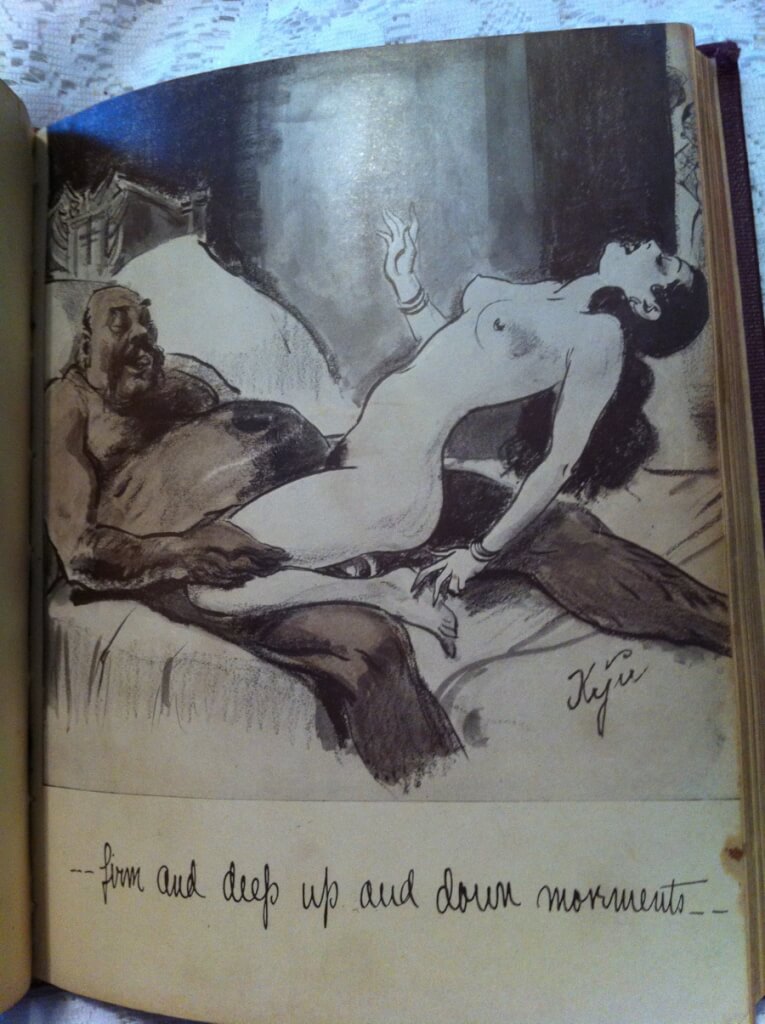
 Three Times a Woman, Grushenka, anonymous [possibly Val Lewton?], illus. "a young Russian residing in Paris, who unfortunately must remain anonymous" (Privately Printed, London [New York], 1933) 9" X 7", 252pp, hardbound no DJ, red boards with gilt title on cover and spine, good condition, minor wear and bumping. Title page reads: "The Story of a Russian Serf Girl Compiled from Contemporary Documents in the Russian Police Files and Private Archives of Russian Libraries" Originally published at New York in 1933 with a false Paris imprint. Val Lewton, the supposed author, was a well known film producer, responsible for a series of good low-budget horror movies in the 1940's by such directors as Robert Wise, Mark Robson and Jacques Tourneur. The book purports to be a flaggelation story written by a Russian living in Paris and then translated to english. The story takes place c. 1728, "shortly after the death of Peter the Great". The main character is Grushenka Pavlovsk. This edition is complete with very explicit illustrations.
Three Times a Woman, Grushenka, anonymous [possibly Val Lewton?], illus. "a young Russian residing in Paris, who unfortunately must remain anonymous" (Privately Printed, London [New York], 1933) 9" X 7", 252pp, hardbound no DJ, red boards with gilt title on cover and spine, good condition, minor wear and bumping. Title page reads: "The Story of a Russian Serf Girl Compiled from Contemporary Documents in the Russian Police Files and Private Archives of Russian Libraries" Originally published at New York in 1933 with a false Paris imprint. Val Lewton, the supposed author, was a well known film producer, responsible for a series of good low-budget horror movies in the 1940's by such directors as Robert Wise, Mark Robson and Jacques Tourneur. The book purports to be a flaggelation story written by a Russian living in Paris and then translated to english. The story takes place c. 1728, "shortly after the death of Peter the Great". The main character is Grushenka Pavlovsk. This edition is complete with very explicit illustrations. -
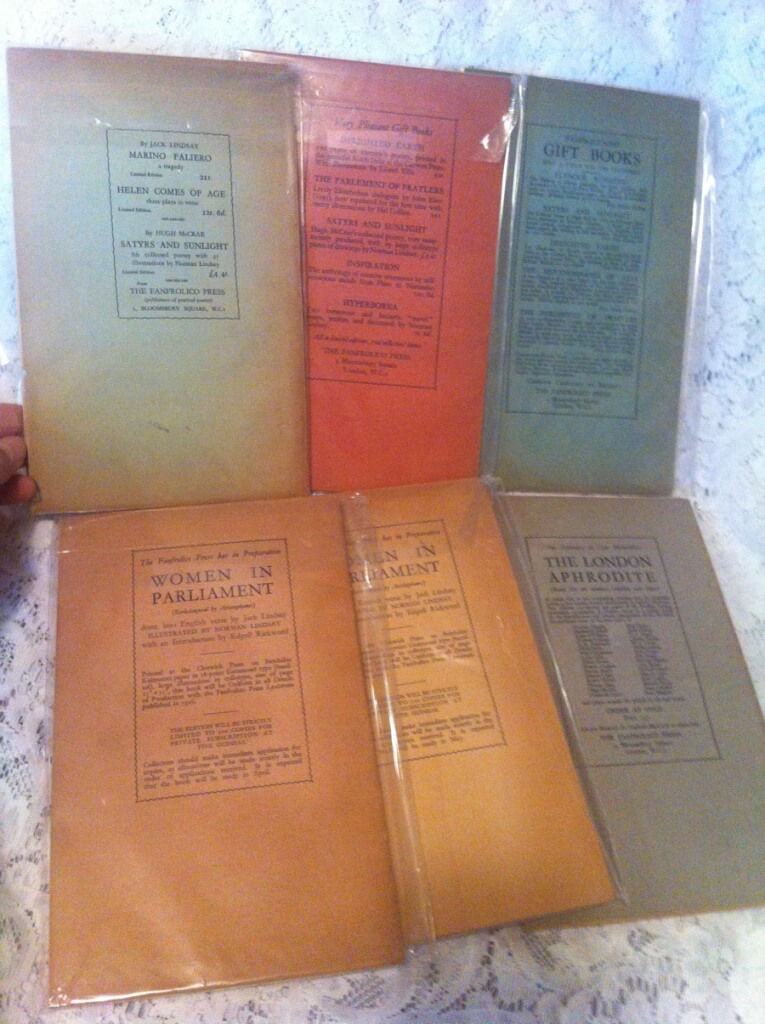
 The London Aphrodite, ed. Jack Lindsay and P.R. Stephensen (Fanfrolico Press, "printed by the Botolph Printing Works", London, 1928 - 29) 9.75" X 6.25", 496pp numbered sequentially throughout series, v1 1-64, v2 45-160, v3 161-232, v4 233-316, v5 317-400, v6 401-496, full set of 6 planned issues, great condition for age, the expected sunning/fading from soft-cover periodical of this era, small ink price stamp to front of v1. A periodical edited by Jack Lindsay and P.R. Stephensen and published in London by the Fanfrolico Press, ran bi-monthly for a planned six issues August 1928 - June 29. Self-described as "A Miscellany of Poems Stories and Essays by Various Hands Eminent or Rebellious." Named as a rebuttal of the conservatism of J.C. Squire's London Mercury, it was committed to the same aesthetic attitudes as Vision. Some prominent writers, including Aldous Huxley, Norman Lindsay, Robert Nichols, Liam O'Flaherty, Edward Marsh, Edward Marsh, Norman Douglas, Stanley Snaith, Alexander Blok, Hugh McCrae, Kenneth Slessor, Philip Lindsay, Brian Penton, P.R. Stephensen, Les Robinson, W.J. Turner, Bertram Higgins, E.J. Rupert Atkinson, Sacheverell Sitwell, T.F. Powys, Rhys Davides, and Edith Hepburn ('Anna Wickham'). Jack Lindsay, the dominant force, used the pseudonym 'Peter Meadows' for several articles. Fanfrolico Press, Australia’s first ‘private press’ in the arts-and-craft tradition, was founded by Jack Lindsay, P. R. Stephensen and John Kirtley, originally in North Sydney in 1923. The press specialized in printings artful, limited editions of classics and forgotten works that were suited to the extravagant style of artist like his father, artist, sculptor and author Norman Lindsay who illustrated many of their books. Fanfrolico was scornful of modernism and with its florid style determinedly backward-looking. They did surprisingly well, despite the lack of business expertise of their young, ambitious "bohemian" owners, eking out a living despite the risky move to London in 1926 and upheavals in ownership that saw the departure in 1927 of Kirtley, and then Stephenson in 1929. Sometime in 1930 they published their last book.
The London Aphrodite, ed. Jack Lindsay and P.R. Stephensen (Fanfrolico Press, "printed by the Botolph Printing Works", London, 1928 - 29) 9.75" X 6.25", 496pp numbered sequentially throughout series, v1 1-64, v2 45-160, v3 161-232, v4 233-316, v5 317-400, v6 401-496, full set of 6 planned issues, great condition for age, the expected sunning/fading from soft-cover periodical of this era, small ink price stamp to front of v1. A periodical edited by Jack Lindsay and P.R. Stephensen and published in London by the Fanfrolico Press, ran bi-monthly for a planned six issues August 1928 - June 29. Self-described as "A Miscellany of Poems Stories and Essays by Various Hands Eminent or Rebellious." Named as a rebuttal of the conservatism of J.C. Squire's London Mercury, it was committed to the same aesthetic attitudes as Vision. Some prominent writers, including Aldous Huxley, Norman Lindsay, Robert Nichols, Liam O'Flaherty, Edward Marsh, Edward Marsh, Norman Douglas, Stanley Snaith, Alexander Blok, Hugh McCrae, Kenneth Slessor, Philip Lindsay, Brian Penton, P.R. Stephensen, Les Robinson, W.J. Turner, Bertram Higgins, E.J. Rupert Atkinson, Sacheverell Sitwell, T.F. Powys, Rhys Davides, and Edith Hepburn ('Anna Wickham'). Jack Lindsay, the dominant force, used the pseudonym 'Peter Meadows' for several articles. Fanfrolico Press, Australia’s first ‘private press’ in the arts-and-craft tradition, was founded by Jack Lindsay, P. R. Stephensen and John Kirtley, originally in North Sydney in 1923. The press specialized in printings artful, limited editions of classics and forgotten works that were suited to the extravagant style of artist like his father, artist, sculptor and author Norman Lindsay who illustrated many of their books. Fanfrolico was scornful of modernism and with its florid style determinedly backward-looking. They did surprisingly well, despite the lack of business expertise of their young, ambitious "bohemian" owners, eking out a living despite the risky move to London in 1926 and upheavals in ownership that saw the departure in 1927 of Kirtley, and then Stephenson in 1929. Sometime in 1930 they published their last book. -

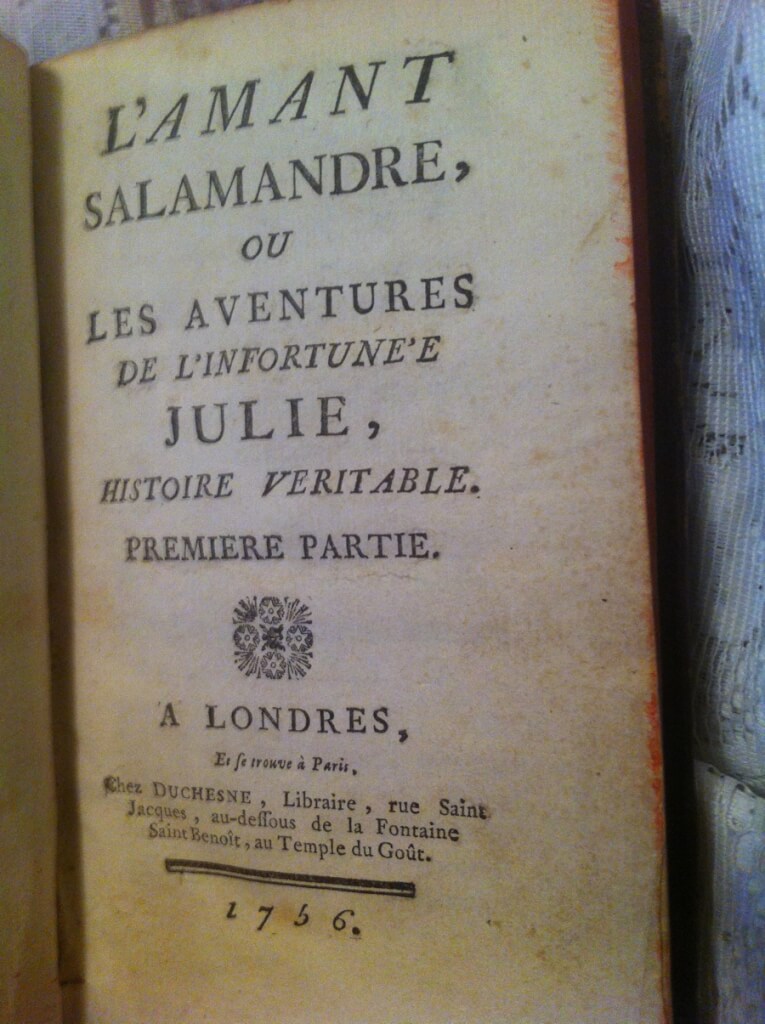 L'Amant Salamandre, ou Les Aventures de l'Infortunée Julie,Histoire Veritable, anonymous [Cointreau] , ("Londres, Et se trouve à Paris. Chez Duchesne" 1756, [first edition]) 4"x6.75", in two parts, 132pp, 135pp, Contemporary mottled calf, gilt decorations on spine, marbled boards, in good condition for age, some splitting at spine, but binding good. Julie is the bizarre tale of a young orphan tricked by her wicked governess into believing in magic. The governess delivers the girl to her son, who attempts to seduce her disguised as Salamandre, a magician. The young girl escapes to a convent, only to cross paths with the governess some time later, who once again tries to procure her for her son. 'Salamandre' is attacked by assassins and confesses his mother's crimes on his death bed. The novel was very popular in it's day. Although very popular in it's day, it's a rare find, especially the original 1756 version.
L'Amant Salamandre, ou Les Aventures de l'Infortunée Julie,Histoire Veritable, anonymous [Cointreau] , ("Londres, Et se trouve à Paris. Chez Duchesne" 1756, [first edition]) 4"x6.75", in two parts, 132pp, 135pp, Contemporary mottled calf, gilt decorations on spine, marbled boards, in good condition for age, some splitting at spine, but binding good. Julie is the bizarre tale of a young orphan tricked by her wicked governess into believing in magic. The governess delivers the girl to her son, who attempts to seduce her disguised as Salamandre, a magician. The young girl escapes to a convent, only to cross paths with the governess some time later, who once again tries to procure her for her son. 'Salamandre' is attacked by assassins and confesses his mother's crimes on his death bed. The novel was very popular in it's day. Although very popular in it's day, it's a rare find, especially the original 1756 version. -
 The 120 Days of Sodom or: The Romance of The School for Libertinage | Being an English rendering of Les 120 Journées de Sodome done by Pieralessandro Casavini, with an Essay by Georges Bataille, D.A.F. de Sade, trans. Pieralessandro Casavini [Austryn Wainhouse] (Olympia Press, Paris, 1957, Traveller's Companion Series) 7" X 4.5", 3 vol. 192pp 203pp 224pp, original green soft wraps, good condition for age, some bumping and small tears to spine, slight soiling. The 120 Days of Sodom, or the School of Libertinage (French: Les 120 Journées de Sodome ou l'école du libertinage) is an unfinished novel by the French writer and nobleman Donatien Alphonse François, Marquis de Sade, written in 1785. Its plot revolves around the activities of four wealthy libertine men who spend four months seeking out the ultimate sexual gratification through orgies, sealing themselves away in an inaccessible castle in the heart of the Black Forest in Germany with four madams and a harem of thirty-six victims, mostly male and female teenagers. The madams relate stories of their most memorable clients, whose crimes and tortures inspire the libertines to likewise and increasingly abuse and torture their victims to their eventual deaths. Sade states he wrote The 120 Days of Sodom over 37 days in 1785 while he was imprisoned in the Bastille. Being short of writing materials and fearing confiscation, he wrote it in tiny writing on a continuous roll of paper, made up of individual small pieces of paper smuggled into the prison and glued together. The result was a scroll 12 metres long that Sade would hide by rolling it tightly and placing it inside his cell wall. Sade incited a riot among the people gathered outside when he shouted to them that the guards were murdering inmates; as a result, two days later on 4 July 1789, he was transferred to the asylum at Charenton, "naked as a worm" and unable to retrieve the novel in progress. Sade believed the work was destroyed when the Bastille was stormed and looted on 14 July 1789, at the beginning of the French Revolution. He was distraught over its loss and wrote that he "wept tears of blood" in his grief. However, the long scroll of paper on which it was written was found hidden in the walls of his cell where Sade had left it, and removed by a citizen named Arnoux de Saint-Maximin two days before the storming. Historians know little about Saint-Maximin or why he took the manuscript. It was first discovered and published in 1904 by the Berlin dermatologist, psychiatrist, and sexologist Iwan Bloch (who used a pseudonym, "Dr. Eugen Dühren", to avoid controversy). Olympia Press was a Paris-based publisher, launched in 1953 by Maurice Girodias as a rebranded version of the Obelisk Press he inherited from his father Jack Kahane. It published a mix of erotic fiction and avant-garde literary fiction, and is best known for issuing the first printed edition of Vladimir Nabokov's Lolita. In its heyday during the mid-fifties Olympia Press specialized in books which could not be published (without legal action) in the English-speaking world. Early on, Girodias relied on the permissive attitudes of the French to publish sexually explicit books in both French and English. The French began to ban and seize the press's book in the late fifties. Precisely 94 Olympia Press publications were promoted and packaged as "Traveller's Companion" books, usually with simple text-only covers, and each book in the series was numbered. The "Ophelia Press" line of erotica was far larger, using the same design, but pink covers instead of green. In Olympia Press was the first to translate this work into English. "120 Days of Sodom" was first published 1954 (pink covers), and then again in their "Traveller's Companion Series" in 1957 which is this edition.
The 120 Days of Sodom or: The Romance of The School for Libertinage | Being an English rendering of Les 120 Journées de Sodome done by Pieralessandro Casavini, with an Essay by Georges Bataille, D.A.F. de Sade, trans. Pieralessandro Casavini [Austryn Wainhouse] (Olympia Press, Paris, 1957, Traveller's Companion Series) 7" X 4.5", 3 vol. 192pp 203pp 224pp, original green soft wraps, good condition for age, some bumping and small tears to spine, slight soiling. The 120 Days of Sodom, or the School of Libertinage (French: Les 120 Journées de Sodome ou l'école du libertinage) is an unfinished novel by the French writer and nobleman Donatien Alphonse François, Marquis de Sade, written in 1785. Its plot revolves around the activities of four wealthy libertine men who spend four months seeking out the ultimate sexual gratification through orgies, sealing themselves away in an inaccessible castle in the heart of the Black Forest in Germany with four madams and a harem of thirty-six victims, mostly male and female teenagers. The madams relate stories of their most memorable clients, whose crimes and tortures inspire the libertines to likewise and increasingly abuse and torture their victims to their eventual deaths. Sade states he wrote The 120 Days of Sodom over 37 days in 1785 while he was imprisoned in the Bastille. Being short of writing materials and fearing confiscation, he wrote it in tiny writing on a continuous roll of paper, made up of individual small pieces of paper smuggled into the prison and glued together. The result was a scroll 12 metres long that Sade would hide by rolling it tightly and placing it inside his cell wall. Sade incited a riot among the people gathered outside when he shouted to them that the guards were murdering inmates; as a result, two days later on 4 July 1789, he was transferred to the asylum at Charenton, "naked as a worm" and unable to retrieve the novel in progress. Sade believed the work was destroyed when the Bastille was stormed and looted on 14 July 1789, at the beginning of the French Revolution. He was distraught over its loss and wrote that he "wept tears of blood" in his grief. However, the long scroll of paper on which it was written was found hidden in the walls of his cell where Sade had left it, and removed by a citizen named Arnoux de Saint-Maximin two days before the storming. Historians know little about Saint-Maximin or why he took the manuscript. It was first discovered and published in 1904 by the Berlin dermatologist, psychiatrist, and sexologist Iwan Bloch (who used a pseudonym, "Dr. Eugen Dühren", to avoid controversy). Olympia Press was a Paris-based publisher, launched in 1953 by Maurice Girodias as a rebranded version of the Obelisk Press he inherited from his father Jack Kahane. It published a mix of erotic fiction and avant-garde literary fiction, and is best known for issuing the first printed edition of Vladimir Nabokov's Lolita. In its heyday during the mid-fifties Olympia Press specialized in books which could not be published (without legal action) in the English-speaking world. Early on, Girodias relied on the permissive attitudes of the French to publish sexually explicit books in both French and English. The French began to ban and seize the press's book in the late fifties. Precisely 94 Olympia Press publications were promoted and packaged as "Traveller's Companion" books, usually with simple text-only covers, and each book in the series was numbered. The "Ophelia Press" line of erotica was far larger, using the same design, but pink covers instead of green. In Olympia Press was the first to translate this work into English. "120 Days of Sodom" was first published 1954 (pink covers), and then again in their "Traveller's Companion Series" in 1957 which is this edition. -
 The Ragionamenti or dialogues of the devine Pietro Aretino, Pietro Aretino, trans. Isidore Liseux (Isidore Liseux, Paris, 1889) 8" X 6", 3 volumes, xxxv+83+89pp, 100+134pp, 129+138pp, half-bound brown morocco over marbled boards, gilt titles on spines, top-edge gilt, other edges deckled, each book has the ex-libris of Boies Penrose II Pietro Aretino (1492-1556) was one of the most important figures in Italian Renaissance literature, and certainly the most controversial. Condemned by some as a pornographer, his infamy was due largely to his use of explicit sexuality and the vulgar tongue of ordinary speech in much of his work. Dialogues center around a conversation between two rather frank, experienced, and sharp-tongued women on the topic of women’s occupations. We learn that at the time there were only three: wife, whore, or nun. Their discussion is a rollicking account of the advantages, perils, and pleasures each profession offers. Not only was Dialogues the first erotic book in the Christian world to be written in the common vernacular, it was but one of the few to describe the obscenity of commercial love, and is thus a cornerstone of both Italian literature and Counter-Renaissance vigour. First dialog: The Life of Nuns Second dialog: The Life of Married Women Third dialog: The Life of Courtesans Fourth dialog: The Education of Pippa Fifth dialog: The Wiles of Men Sixth dialog: The Bawd’s Trade Isidore Liseux (1835-1894) was a French bibliophile and publisher of erotica and curiosa. His publications were mostly rare texts of 16th to 18th century authors, hard to find and little known books which were usually translated and annotated by his friend and associate Alcide Bonneau or by Liseux himself. Liseux and Bonneau, both ex-priests, knew each other since seminary. His books were published in small numbers, on high quality paper, and with excellent typography. His usual printers were Claude Motteroz, Antoine Bécus, and later Charles Unsinger. Liseux’s books were published openly as the climate was more permissive in Paris at the time. His books were so well regarded that pirates of his books and even unrelated books bearing his imprint with a false date were published clandestinely into the 20th century. French poet, Guillaume Apollinaire wrote: “The publications of Liseux are more and more sought after because they are correct, beautiful and rare.” (Le flaneur des deux rives, 1918). Time Magazine, Monday, May 11, 1936 Youngish Pennsylvanians whose Progressive fathers frightened them with the name of BOIES PENROSE a quarter century ago could look forward last week to bemusing their own children with that great name some day. In Philadelphia Boies Penrose II, nephew of Pennsylvania's longtime (1897-1921) Senator and Republican boss, received a Republican nomination to Congress in last week's primary. A rich and cultured Harvard man like his late uncle, 34-year-old Boies II has hitherto devoted himself to scholarship and society, is the owner of a notable collection of etchings, engravings, manuscripts and rare books. When he decided few months ago to make a career for himself in politics, leaders of Philadelphia's Republican machine warmly welcomed a young man with so potent a name, so fat a pocketbook. Candidate Penrose, who owns a 125-acre estate on the Main Line at swank Devon where he takes his own and neighbors' small children for rides on his mile-long miniature railroad, promptly established a residence in Philadelphia by renting an apartment, the address of which he is constantly forgetting.— "My platform," he announced in fastidious Bostonese, "will be the Horse & Buggy, or Save the Constitution." In the Republican split of 1912 Boies Penrose temporarily lost his State leadership to the Bull Moose faction, which included an ardent Young Roosevelt worshipper named Gifford Pinchot. While one set of Philadelphia voters was lifting the name of Penrose up last week, another group was setting the name of Pinchot down. In a district inhabited largely by factory workers whose cause she has championed many a time on the picket line, red-haired Mrs. Gifford Pinchot made her third race for a Republican nomination to the House, suffered her third defeat.
The Ragionamenti or dialogues of the devine Pietro Aretino, Pietro Aretino, trans. Isidore Liseux (Isidore Liseux, Paris, 1889) 8" X 6", 3 volumes, xxxv+83+89pp, 100+134pp, 129+138pp, half-bound brown morocco over marbled boards, gilt titles on spines, top-edge gilt, other edges deckled, each book has the ex-libris of Boies Penrose II Pietro Aretino (1492-1556) was one of the most important figures in Italian Renaissance literature, and certainly the most controversial. Condemned by some as a pornographer, his infamy was due largely to his use of explicit sexuality and the vulgar tongue of ordinary speech in much of his work. Dialogues center around a conversation between two rather frank, experienced, and sharp-tongued women on the topic of women’s occupations. We learn that at the time there were only three: wife, whore, or nun. Their discussion is a rollicking account of the advantages, perils, and pleasures each profession offers. Not only was Dialogues the first erotic book in the Christian world to be written in the common vernacular, it was but one of the few to describe the obscenity of commercial love, and is thus a cornerstone of both Italian literature and Counter-Renaissance vigour. First dialog: The Life of Nuns Second dialog: The Life of Married Women Third dialog: The Life of Courtesans Fourth dialog: The Education of Pippa Fifth dialog: The Wiles of Men Sixth dialog: The Bawd’s Trade Isidore Liseux (1835-1894) was a French bibliophile and publisher of erotica and curiosa. His publications were mostly rare texts of 16th to 18th century authors, hard to find and little known books which were usually translated and annotated by his friend and associate Alcide Bonneau or by Liseux himself. Liseux and Bonneau, both ex-priests, knew each other since seminary. His books were published in small numbers, on high quality paper, and with excellent typography. His usual printers were Claude Motteroz, Antoine Bécus, and later Charles Unsinger. Liseux’s books were published openly as the climate was more permissive in Paris at the time. His books were so well regarded that pirates of his books and even unrelated books bearing his imprint with a false date were published clandestinely into the 20th century. French poet, Guillaume Apollinaire wrote: “The publications of Liseux are more and more sought after because they are correct, beautiful and rare.” (Le flaneur des deux rives, 1918). Time Magazine, Monday, May 11, 1936 Youngish Pennsylvanians whose Progressive fathers frightened them with the name of BOIES PENROSE a quarter century ago could look forward last week to bemusing their own children with that great name some day. In Philadelphia Boies Penrose II, nephew of Pennsylvania's longtime (1897-1921) Senator and Republican boss, received a Republican nomination to Congress in last week's primary. A rich and cultured Harvard man like his late uncle, 34-year-old Boies II has hitherto devoted himself to scholarship and society, is the owner of a notable collection of etchings, engravings, manuscripts and rare books. When he decided few months ago to make a career for himself in politics, leaders of Philadelphia's Republican machine warmly welcomed a young man with so potent a name, so fat a pocketbook. Candidate Penrose, who owns a 125-acre estate on the Main Line at swank Devon where he takes his own and neighbors' small children for rides on his mile-long miniature railroad, promptly established a residence in Philadelphia by renting an apartment, the address of which he is constantly forgetting.— "My platform," he announced in fastidious Bostonese, "will be the Horse & Buggy, or Save the Constitution." In the Republican split of 1912 Boies Penrose temporarily lost his State leadership to the Bull Moose faction, which included an ardent Young Roosevelt worshipper named Gifford Pinchot. While one set of Philadelphia voters was lifting the name of Penrose up last week, another group was setting the name of Pinchot down. In a district inhabited largely by factory workers whose cause she has championed many a time on the picket line, red-haired Mrs. Gifford Pinchot made her third race for a Republican nomination to the House, suffered her third defeat.













